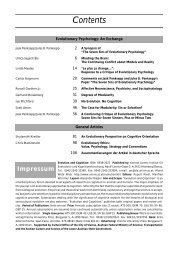Contents - Konrad Lorenz Institute
Contents - Konrad Lorenz Institute
Contents - Konrad Lorenz Institute
Create successful ePaper yourself
Turn your PDF publications into a flip-book with our unique Google optimized e-Paper software.
The Effect of Fertility Risk on Relationship Scrutiny<br />
conception, these women may differ from women<br />
not taking the pill in important ways (e.g., their sexual<br />
attitudes, their commitment to the relationship).<br />
Thus, I decided to exclude these women from<br />
the low fertility risk group (LFR, N = 20).<br />
Results<br />
To begin with, I calculated the statistical association<br />
between the relationship satisfaction composite<br />
and a mean composite of the 64 relationship quality<br />
features for each group. For the high fertility risk<br />
group, reliance on specific relationship quality features<br />
accounted for approximately 88% of the variance<br />
(r = .94) in relationship satisfaction. For the<br />
low fertility risk group, however, reliance on relationship<br />
quality features accounted for only 61% of<br />
that variance (r = .78). This difference is significant,<br />
z = 2.06, p < .05, and cannot be traced back to disparities<br />
in relationship satisfaction between the two<br />
groups, t(37) = 1.14, p > .26, or to discrepancies in<br />
variances F(1,37) = 2.93, p > .095.<br />
I then proceeded to examine single-order correlations<br />
between the 64 features of the prototype of relationship<br />
quality and relationship satisfaction for<br />
the HFR group and the LFR group independently.<br />
Fifty-two of the 64 correlations were higher in the<br />
HFR than in the LFR group. These results are all the<br />
more impressive given that participants, as a whole,<br />
were fairly satisfied with their relationships<br />
(M = 5.66, SD = 1.09), thereby attaining the maximum<br />
possible correlation. (Since these features are<br />
highly correlated, it is not appropriate to use the<br />
sign-test to check whether this distribution differs<br />
significantly from chance.)<br />
Taking a closer look at each individual correlation,<br />
I found that women in the HFR group, unlike<br />
the LFR group, base their relationship satisfaction<br />
more on features such as “being there for each<br />
other”, “knowing partner”, “security”, “sexuality”,<br />
and “safety”, for example, to mention a few (see Table<br />
1, for details). This pattern provides support to<br />
the assumption that highly fertile women are especially<br />
responsive to those qualities of their partners<br />
and relationships which indicate stable and secure<br />
pair bonding. Women in the LFR group, however,<br />
base their relationship evaluation more on features<br />
dealing with similarities: “mutual goals”, “similar<br />
interests”, “similar beliefs”, features which are considered<br />
peripheral for the prototype of relationship<br />
quality (HASSEBRAUCK 1997).<br />
In order to analyze these differences in content<br />
even further, I calculated 4 sub-scales of the 64 features<br />
of the prototype of relationship quality, which<br />
correspond to the four factors—intimacy<br />
(alpha = .87), agreement (alpha = .82), independence<br />
(alpha = .82), and sexuality (alpha = .84), reported<br />
by HASSEBRAUCK and FEHR (2002). HASSEBRAUCK/FEHR<br />
(2002, Study 4) have already determined that the<br />
correlation between intimacy and relationship satisfaction<br />
is the highest, followed by agreement, sexuality,<br />
and independence. Correlations between the<br />
4 subscales and relationship satisfaction in this<br />
study depict however an interesting deviation from<br />
the reported pattern (Table 2). All in all, in accordance<br />
with the above-mentioned results, correlations<br />
within the LFR group are lower than those<br />
within the HFR group. More important, however, is<br />
the difference with respect to intimacy. In the LFR<br />
group, intimacy and relationship satisfaction correlated<br />
significantly lower (r = .61, p < .01) than in the<br />
HFR group (r = .89, p < .001), z = 2.02, p < .05). Emotional<br />
support, trust, and understanding, to name a<br />
few, are significantly less important in the low fertile<br />
phases of the female cycle.<br />
It is not surprising that the correlation between<br />
sexuality and relationship satisfaction is greater in<br />
the HFR group than in the LFR group. However, this<br />
difference is not significant, z = 1.41, p > .14. The<br />
pattern of results for independence was not expected.<br />
Women in the fertile phases based relationship<br />
satisfaction evaluation more on independence<br />
than women in the low fertile phases.<br />
Discussion<br />
The maintenance of a satisfactory relationship is a<br />
task that is distinguished by high personal relevance<br />
for both men and women, and a wide variety of<br />
emotional and social consequences are associated<br />
with a stable, satisfactory relationship. Relationships<br />
however present different tasks for men and<br />
women—not only against an evolutionary background.<br />
In societies where women have poorer access<br />
to educational facilities and socio-economical<br />
resources than men, a long-term romantic relationship<br />
seems to offer women the opportunity of upward<br />
mobility, in which women exchange one of<br />
their few possessions, their “capacity to give birth”,<br />
for material security.<br />
The fact that women value different characteristics<br />
than men when selecting their partner is comprehensible,<br />
and is well documented in the literature<br />
(for example, BOTWIN/BUSS/SHACKELFORD 1997;<br />
TOWNSEND/WASSERMAN 1998; KASSER/SHARMA 1999,<br />
to name a few newly conducted studies; for a gen-<br />
Evolution and Cognition ❘ 119 ❘ 2003, Vol. 9, No. 2








